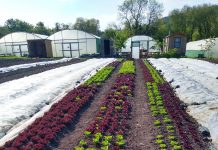What can I write about in February? The winter is such a difficult time for leaves to grow or look happy, and if they do then wildlife moves in and eats them.
Yet there are still many good harvests of below and above ground roots (above ground being swede, turnip, beetroot) and leaf crops such as leek, kale and cabbage. The savoy cabbage seems to be the only cabbage not attacked by birds in our garden—I don’t know the reason but I’m very happy about it. The curly kale has netting over it and looks beautiful and prosperous. We pick the kale about three times, harvesting mid-sized leaves, leaving the bottom ones and also the top ones to grow, ready for the next pick. Then when sprouting flower buds arrive these are delicious too.
Red Drumhead cabbage is still under its Enviromesh, but being eaten by rats, which isn’t an appetising thought. If we cut and store them, they lose their taste, sometimes rot and start sprouting. This is the case with most stored veg, and so we leave most outside, even the celeriac if the woodlice problem isn’t too bad.
Has anyone noticed that Red Drumhead seed has been variable of late—we sowed two different packets last year, and some are dark red and cook crisp and crunchy, the others are almost variegated and have an unexciting texture. The reason we used two different packets is because we noticed it the previous year, and are wondering what’s going on. This is the ‘fun’ with buying seed at all times!
Where we have garlic growing since November in between salad, such as true spinach, there are no slug holes in the leaves. Finding this, we have ‘planted’ bits of garlic from the kitchen waste all around the salad crops, especially near lawn edging.
This time of year is no joke in the garden, so no joke this month, readers—sorry!
What to sow this month
Late in the month you can sow broad beans variety Aquadulce, and early and second early potatoes. Put fleece over both to warm soil which will also keep birds from eating the beans. Potatoes shoots should emerge in about a month, and keep well fleeced until the last frost. In return for this extra effort you should get an earlier and bigger crop.
Indoors or in a heated greenhouse you can sow quite a few crops, so long as you have somewhere warm enough to transplant them when they outgrow their modules. Beetroot, lettuce, true spinach, summer cabbage and parsley are examples, only sow peppers and tomatoes if you have a heated greenhouse.








